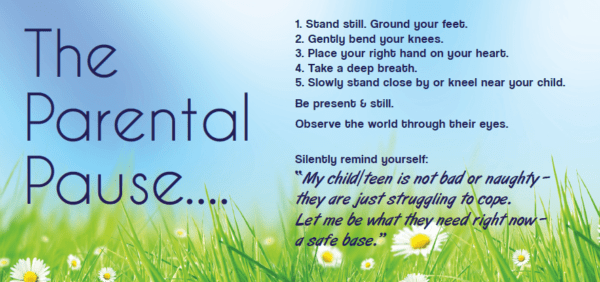Anger, Self-regulation & Tantrums, Essential Kids Blog, Posts for Parents, Press & Online, Self-care for Parents
The power of the parental pause

In those tough parenting moments, this secret may be your saving grace.
There are many moments when parenting our children, whether they be 5 or 15, that push us to the point of losing our s^#t!
Perhaps, for the umpteenth time that day, your toddler has melted down about something huge like you gave him the wrong coloured cup, you cut her sandwich into four not three, or he wanted to keep pouring juice on the couch. Perhaps your blessed cherubs are fighting AGAIN, or your moody tween/teen rolls their eyes or, worse, flips you the bird when you request a simple chore to be done.
There is a limit to human patience and you are not a lousy parent if you occasionally lose the plot – shouting, stomping away or maybe slamming a door or locking yourself in the toilet wondering why you ever thought having children was a good idea.
It’s OK … this is simply a sign of a cortisol overload that has triggered your sleep-deprived primitive brain – you know the fight/flight response. Actually it’s much the same as what happens with your beloved child – a massive overload of the stress hormone cortisol.
The key difference between the child and adult overload is that you have a mature brain – and a pre-frontal cortex that has the ability to use metacognition, or the ability to think about your thinking, to make a different choice about how you react.
Of course when you add stress, serious sleep deprivation, lack of caffeine, swirling hormones – especially for mums – and possibly hunger and exhaustion it can be difficult to access your freaking pre-frontal cortex.
Let me reassure you, your pre-fontal cortex has not been stolen nor have you left it somewhere although it may feel like that sometimes. You are not a bad person or a useless parent. You simply need to master the art of the Parental Pause.
What is the Parental Pause?
This magical technique is beyond simple and will help you at times of high tension to be the person you wished you could be without hiding in your bedroom and eating a family block of fruit and nut chocolate (note this healthy choice: it contains fruit and nuts).
It works like this:
1. You stop moving. You ground your feet.
2. Gently bend your knees.
3. Place your right hand on your heart.
4. Take a deep breath. Maybe another two deep breaths.
5. Then you slowly stand close by or kneel near your child.
Be present.
Be still.
Observe calmly the world through your child’s eyes.
Inwardly – repeat these words silently:
“My child/teen is not bad or naughty – they are just struggling to cope with their world. This is normal developmentally. Let me be what they need right now – a safe base.”
That’s it!

When our children have unmet needs they are unable to express, this triggers the stress hormone. They may be hungry, tired, hot, cold, frustrated, feeling unloved, invisible, stressed from school stuff or hurt from an online attack – it’s real for them.
Given they are young, their ability to manage big ugly feelings is still developing and being near someone who makes them feel safe can help those stress levels drop.
Using reason with children of all ages is not always useful because reason needs a mature pre-frontal cortex to fully grasp it. Talking when a child is in heightened meltdown can sometimes make things worse because their primitive brain has hijacked their ability to make sense of spoken words. For boys especially it can totally trigger more frustration and can be like adding fuel to the fire!
So the secret to the power of the parental pause is one of silent acceptance of what is – not through the lens of judgement of good or bad – just ‘is’.
Then know that much like everything in life, ‘this too will pass’.
Sometime later in the day you might re-visit the meltdown to see if you can help your child identify what triggered it. However often just knowing this is developmentally normal and happens in every home and family can be helpful.
Taking frequent deep breaths, or deep sighs, as a parent can help to keep your stress levels down. I have heard children tell their mum she needs to take three breaths when she is getting angry and that’s a good thing as they will tend to copy the same calming behaviour.
Deep breathing creates some much-needed serotonin – the calming neurotransmitter. Of course this same effect comes from many high fat/high sugar foods or sweet drinks or alcohol, but breathing is ideal because you can help yourself feel better anywhere, anytime and it has zero kilojoules or after-effects!
Safe touch through hugs, cuddles or gentle tickles also creates serotonin – again zero kilojoules.
You can also model a calm-down space – a chair or a beanbag – where adults or kids in your house can go when they need some time to ‘chillax’.
So next time your primitive brain is triggered, have a go at practising the parental pause and see if it helps. Remember if it doesn’t, there is always fruit and nut chocolate.
If you enjoy this post and want more moments of calm in your home, check out Maggie’s self-paced online course, Calming Our Children & Calming Our Homes.
Image credit: ©focuspocusltd/Depositphotos.com




 Manage Membership
Manage Membership